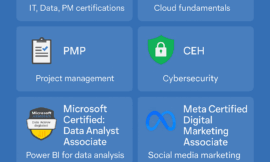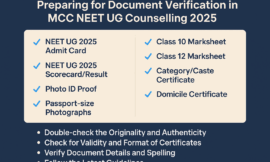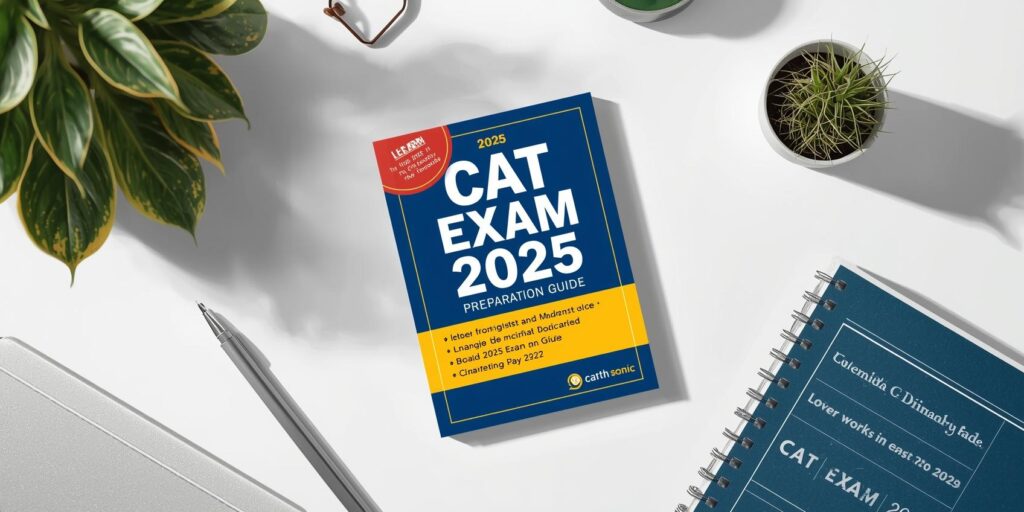
CAT Exam 2025 Preparation Guide: Syllabus PDF, Exam Date, Eligibility, Fees, Pattern, and How to Prepare at Home
The Common Admission Test (CAT) 2025 is one of the most competitive MBA entrance exams in India.
Every year, over 2.5 lakh aspirants appear for this test, competing for admission to the prestigious Indian Institutes of Management (IIMs) and other top B-schools.
With CAT being a gateway to dream careers in management, proper preparation is essential.
But the good news?
You don’t need expensive coaching.
With the right guidance, study material, and strategy, you can prepare effectively at home.
This comprehensive guide covers:
- CAT Exam 2025 important dates
- Eligibility and fees
- Latest exam pattern
- Syllabus PDF and topic breakdown
- Step-by-step preparation strategy
- How to fill the CAT exam form
- CAT vs XAT exam differences
- Exam day tips and mistakes to avoid
Let’s dive in!
What is CAT Exam?
CAT stands for Common Admission Test.
It is a computer-based aptitude test conducted by the IIMs every year.
The exam checks your:
- Quantitative skills
- Data interpretation & logical reasoning
- Verbal ability & reading comprehension
Purpose: CAT scores are primarily used for admission into the IIMs’ MBA/PGP programs. But over 1,200 top business schools across India also accept CAT scores.
If you want to study at an IIM or any leading MBA institute, CAT is your first step.
CAT Exam 2025 Important Dates
The official notification for CAT 2025 has been released by IIM Kozhikode.
Here are the key dates you must note:
- Notification release date: July 2025
- Registration opens: 1 August 2025 (10:00 AM)
- Registration closes: 13 September 2025 (5:00 PM)
- Admit card release: October 2025
- Exam date: 30 November 2025 (Sunday)
- Result announcement: January 2026
What Is a Proctored Exam and How Does It Work?
CAT Exam Eligibility 2025
To apply for CAT 2025, you must meet the following criteria:
- Educational Qualification
- Must hold a Bachelor’s degree (minimum 3 years) from a recognized university.
- Minimum 50% marks (or equivalent CGPA) for General, EWS, and OBC categories.
- Minimum 45% marks for SC, ST, and PwD categories.
- Final-Year Students
- Students in their final year of graduation are eligible. They must complete their degree before admission deadlines.
- Age Limit
- There is no upper age limit to appear for CAT.
👉 Note: Even if you are a working professional or a non-engineering graduate, CAT is open for you. Diversity is valued by IIMs.
CAT Exam Fees 2025
The application fees vary according to category:
- General / OBC / EWS: ₹2,600
- SC / ST / PwD: ₹1,300
Payment mode: Online only—through debit/credit cards, net banking, or UPI.
Once paid, the fee is non-refundable. Keep transaction proof safe until admit card download.
CAT Exam Pattern 2025
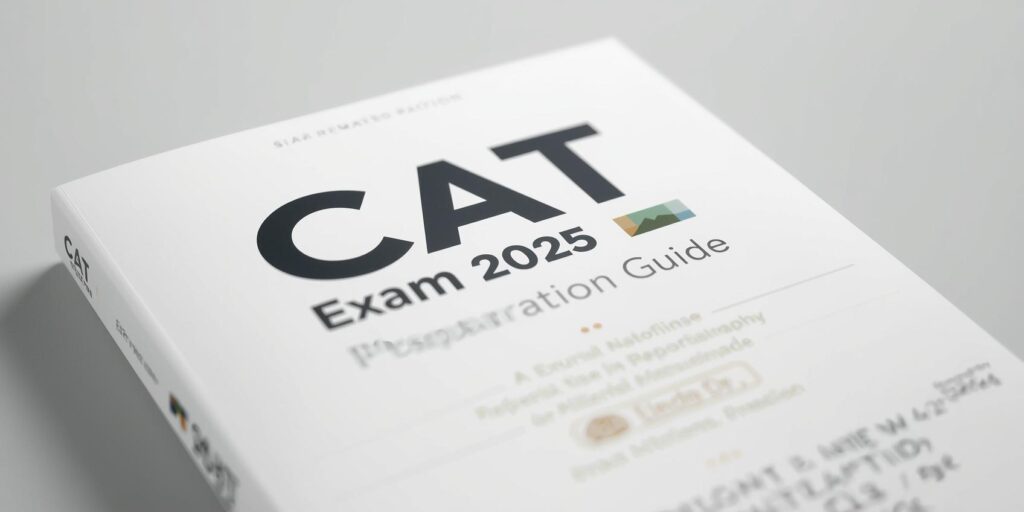
Understanding the exam pattern is the first step toward effective preparation.
Structure of CAT 2025:
- Mode: Computer-based (online at test centres)
- Total duration: 120 minutes (2 hours)
- Sections: 3 (each section has 40 minutes)
- Total questions: ~66–68 (varies slightly)
- Marking scheme:
- +3 marks for every correct answer
- -1 mark for incorrect MCQ
- No negative marking for non-MCQs (TITA – Type In The Answer)
How NEP 2020 Will Reshape Indian Education by 2030
Section-wise breakup:
| Section | Duration | Number of Questions |
|---|---|---|
| VARC (Verbal Ability & Reading Comprehension) | 40 mins | 22–24 |
| DILR (Data Interpretation & Logical Reasoning) | 40 mins | 20–22 |
| QA (Quantitative Ability) | 40 mins | 22–24 |
👉 Note: Since each section is time-bound, you cannot move between sections. Learn sectional time management during mock tests.
CAT Exam Syllabus 2025
Although the official notification does not mention a fixed syllabus, analysis of past papers gives us a clear picture of what to study.
1. Verbal Ability & Reading Comprehension (VARC)
- Reading comprehension (long & short passages)
- Para jumbles and para completion
- Sentence correction and grammar
- Vocabulary and synonyms/antonyms
- Inference-based questions
2. Data Interpretation & Logical Reasoning (DILR)
- Tables, charts, graphs
- Caselets (multi-source data)
- Venn diagrams & set theory
- Arrangements and puzzles
- Blood relations and binary logic
3. Quantitative Ability (QA)
- Arithmetic: Percentages, Ratio-Proportion, Averages, Time-Speed-Distance, Time & Work
- Algebra: Linear & quadratic equations, inequalities, sequences, functions
- Geometry & Mensuration: Triangles, circles, coordinate geometry, area & volume
- Number System, Probability, Permutations & Combinations
Boost Your Career with Free SWAYAM Certification Courses
CAT Exam Syllabus PDF—Where to get it & how to use it
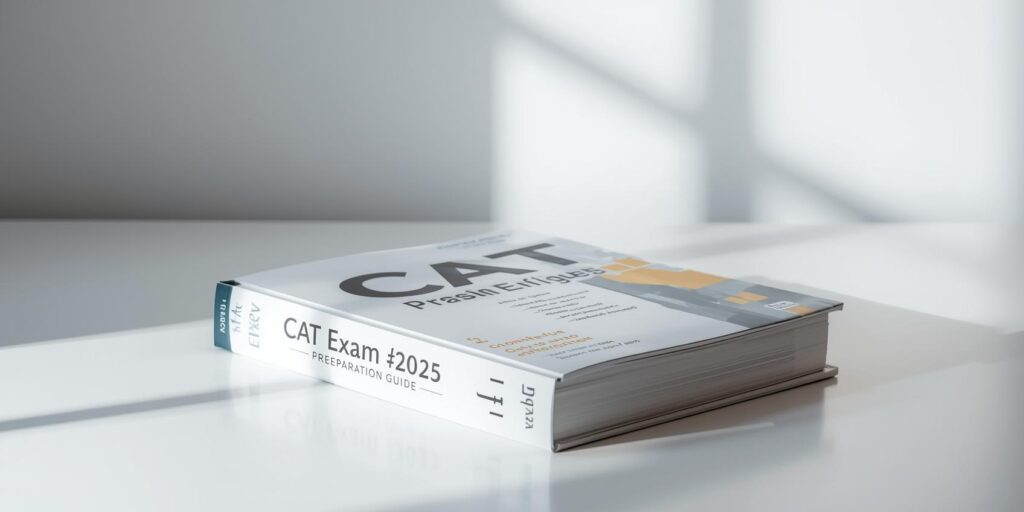
- The official IIM site provides the notification and exam instructions—link and reference the PDF/notification page while publishing your post.
- Trusted education portals (Testbook, CollegeDekho, and IMS) provide friendly, printable syllabus PDFs that break topics into beginner/intermediate/advanced lists. Use them to make a weekly study plan.
How to use the PDF:
- Print or save a copy.
- Tick topics you’re comfortable with and circle those you’re weak in.
- Make a 12-week plan focusing more time on weak areas.
- Add weekly mock tests and revision days.
How to Prepare for CAT Exam at Home (Step-by-Step Guide)
Many toppers crack CAT without coaching. All you need is discipline, the right resources, and mock test analysis.
Here’s a 12-month home preparation plan:
Step 1: Foundation Building (Months 1–3)
- Revise NCERT Class 8–10 math for QA basics.
- Read daily editorials from The Hindu, The Economist, or Indian Express for VARC.
- Start solving simple logic puzzles and DI sets.
Step 2: Strengthening Concepts (Months 4–6)
- Solve topic-wise QA questions (30–40 daily).
- Attempt 2–3 RC passages per week.
- Practice one DILR set daily.
- Take sectional mocks every weekend.
Step 3: Mock Tests & Strategy (Months 7–9)
- Start full-length mocks (at least one per week).
- Analyze mistakes after each test—focus on accuracy.
- Learn to skip time-consuming questions.
Step 4: Final Polishing (Months 10–12)
- Increase mock frequency to 2–3 per week.
- Revise formulas, shortcuts, and grammar rules.
- Focus on weak areas, but don’t ignore strengths.
- Stay calm; reduce the study load in the last week.
Step 5: Last week
- Light revision only. No heavy new topics.
- Revise formula sheets, practice 2 short mocks, relax, and sleep well.
Daily routine suggestion (3–4 hours/day if working):
- 60–90 min QA practice (concepts + questions).
- 45 min DILR (puzzles + data sets).
- 30–45 min VARC (1 RC + grammar/para jumbles).
- 30 min revision of weak topics or mocks analysis.
👉 Remember: Mock test analysis is more important than just taking mocks. Spend 2–3 hours reviewing every test.
Top Management Programs for Young Leaders in India
How to prepare for MBA CAT at home — resources (books, mocks, apps)
Books / Topics
- VARC: Read widely; use source RCs; books: “High School English Grammar & Composition” (for basics), collections of RCs.
- QA: NCERT Class 8–10 for basics; R.S. Aggarwal for practice; Arun Sharma for advanced practice.
- DILR: Arun Sharma’s DILR, “How to Prepare for Data Interpretation for CAT” (topic-specific books), and puzzle books.
Mocks & online resources
- Official mock tests (if IIM releases them) — always try these first.
- Reputed coaching platform mocks: IMS, Career Launcher, TIME, 2IIM, Handa Ka Funda — use a mix to get different styles.
- Apps and websites: Testbook, BYJU’S Exam Prep, Unacademy, and others provide sectional practice and topic-wise tests. Use free trials or paid subscriptions based on reliability.
Important: Balance quality over quantity — one well-analysed mock is more useful than five unanalysed mocks.
Section-wise strategy (practical how-to)
VARC strategy
- Daily reading habit (30–45 min) — editorials, essays, economics writing.
- Practice 2 long RCs per week, learn to answer inference and tone questions.
- Learn skimming techniques and practice summarizing paragraphs in one line.
DILR strategy
- Learn to quickly interpret tables and charts — practice reading speed and inference.
- Solve puzzles daily (arrangements, sets, cases). Time each puzzle and improve speed.
- When stuck on a set in the exam, don’t waste time — move on.
QA strategy
- Master arithmetic basics (percent, ratio, profit-loss) — they’re high frequency.
- Make a formula sheet for quick revision.
- Do timed question banks (10–15 questions in 20 minutes) to build speed.
Recommended Books and Resources
For QA:
- NCERT Class 8–10 Maths
- Quantitative Aptitude by R.S. Aggarwal
- How to Prepare for Quantitative Aptitude by Arun Sharma
For VARC:
- Word Power Made Easy (Norman Lewis)
- High School English Grammar & Composition (Wren & Martin)
- Editorial reading (The Hindu, Indian Express)
For DILR:
- How to Prepare for Data Interpretation & Logical Reasoning by Arun Sharma
- Puzzle books & online reasoning sets
Mocks & Online Platforms:
- Official IIM CAT sample papers
- Career Launcher, IMS, TIME, 2IIM mock test series
CAT Exam Form 2025 – How to Apply
Follow these steps to register:
- Visit iimcat.ac.in.
- Create a profile with email & phone number.
- Fill in personal, academic, and work experience details.
- Upload a scanned photo, signature, and category certificate (if applicable).
- Pay the application fee online.
- Choose preferred exam cities (up to 5).
- Download the application confirmation.
👉 Note: Keep scanned documents ready in the required format before applying.
CAT vs XAT Exam
Many MBA aspirants also appear for XAT (Xavier Aptitude Test), conducted by XLRI Jamshedpur.
| Feature | CAT | XAT |
|---|---|---|
| Conducting Body | IIMs | XLRI Jamshedpur |
| Exam Date | 30 Nov 2025 | Jan 2026 |
| Sections | VARC, DILR, QA | VARC, DM (Decision Making), QA, GK |
| Duration | 2 hours | 3 hours |
👉 If you are targeting XLRI or related institutes, prepare separately for Decision Making and General Knowledge, which are unique to XAT.
CAT 2025 Exam Day Tips
- Carry the admit card & valid photo ID.
- Reach the center at least 1 hour early.
- Use rough sheets effectively.
- Manage sectional time wisely (40 minutes per section).
- Don’t panic if one section feels tough—all candidates face the same.
Common Mistakes to Avoid
- Ignoring weak areas for too long.
- Taking mocks without analysis.
- Relying only on shortcuts without mastering basics.
- Over-studying in the last week and burning out.
How to use mock tests effectively (analysis checklist)
For every mock:
- Score & percentile: note raw score and scaled sectional scores.
- Time map: where did you spend most time? Which section slowed you down?
- Question map: mark wrong vs. right question types (concept vs. careless mistake).
- Action plan: 3 things to fix for next mock (learn concept, speed practice, change question attempt order).
Mental fitness, exam day tips, and what to carry
- Sleep well the week before; do light revision only the last 2 days.
- Exam day: carry admit card, valid photo ID, a simple clear water bottle and face mask (if required). Check reporting time on the admit card.
- At the test centre: follow invigilator instructions, use the rough sheet provided, manage time strictly per section (40 mins each). Don’t switch sections mid-slot (sectional locks apply).
What happens after the exam
- Answer key / response sheet: Some years IIMs release response sheets and allow challenge windows. Watch official portal.
- Results: Typically declared in January (result date varies). Shortlisted candidates get called for WAT/PI/Group Discussion rounds per institute.
- Final selection: based on CAT score, academic record, work experience, and personal interviews. Each IIM has its own weightage system.
What to do in first 60 days
- Day 1: Take diagnostic mock.
- Days 2–15: Build fundamentals (NCERT + chosen QA book).
- Days 16–30: Start DILR and VARC basics.
- Days 31–45: First full-length sectional mocks and analysis.
- Days 46–60: Fix top 5 weak topics and take 4 full tests (analyze thoroughly).
Expected Cut-Offs and Percentiles
- Top IIMs (A, B, C): 98–99+ percentile
- Newer IIMs: 90–95 percentile
- Non-IIM top B-schools (SPJIMR, FMS, MDI, etc.): 90–97 percentile
👉 Cut-offs vary each year and by category. Always check the specific institute’s admission policy.
How to make your preparation foolproof
- Consistency beats cramming. A steady 2–3 hours daily practice builds competence.
- Quality mocks and honest analysis. Learn from mistakes — that’s where score improvement happens.
- Know the test-day rules. Read the official instructions on the admit card and IIM website.
Conclusion on CAT Exam 2025 Preparation Guide
The CAT Exam 2025 is your ticket to a top management career.
While it’s competitive, a disciplined strategy, regular mocks, and consistent study habits can help you crack it.
Key takeaways:
- Start early, and follow a structured plan.
- Practice daily for VARC, QA, and DILR.
- Take and analyze mock tests regularly.
- Stay calm, confident, and focused.
Frequently Asked Questions
Is there any age limit for CAT?
No upper age limit. Eligibility is based on graduation criteria, not age.
Can final year students apply?
Yes — candidates in final year may apply but must provide proof of degree at a later stage.
Can I change my exam centre after registration?
Usually not after the registration window closes; check the official portal for any correction windows.
Does CAT have an interview round?
CAT itself is only the test; shortlisting by IIMs leads to further rounds (GD/WAT/PI) for final selection.
How to start preparation for CAT 2025?
1. Understand the CAT 2025 Exam Structure
Before you start studying, know what you’re preparing for:
- Sections: VARC (Verbal Ability & Reading Comprehension), DILR (Data Interpretation & Logical Reasoning), QA (Quantitative Ability).
- Duration: 2 hours (40 mins per section).
- Marking: +3 for correct, -1 for wrong (MCQs).
👉 This helps you know where you stand and what to focus on first.
2. Take a Diagnostic Mock Test
- Attempt one full-length CAT mock (without worrying about scores).
- Analyze results → Which section is your strongest? Which is weakest?
- This gives you a baseline and helps you plan your study.
3. Build Your Basics (First 2–3 Months)
- For QA: Revise NCERT Maths (Class 8–10) → percentages, ratios, algebra, geometry.
- For VARC: Start reading daily (newspapers, editorials, magazines). Try 1 Reading Comprehension passage daily.
- For DILR: Begin with simple puzzles, bar graphs, and tables.
👉 Focus on concept clarity before speed.
4. Make a Daily Routine
Even if you study 2–3 hours daily, consistency matters more than long hours. Example:
- 1 hour QA basics
- 45 min VARC (reading + practice)
- 45 min DILR puzzles
- 30 min revision / error analysis
5. Collect the Right Resources
- Books: Arun Sharma (QA, DILR, VARC), NCERTs, Word Power Made Easy (vocab).
- Mocks: TIME, IMS, Career Launcher, or 2IIM test series.
- Free practice: Editorials for VARC, Puzzle apps for DILR, NCERTs for QA.
6. Slowly Add Mock Tests (After 3 Months)
- Start with sectional tests (focus on weak areas).
- After 3–4 months of basics, add full-length mocks (1 per week).
- Spend 2–3 hours analysing each mock → this is where real improvement happens.
7. Track Progress & Adjust
- Keep a notebook for mistakes (wrong concepts, silly errors, time management issues).
- Revisit it weekly.
- Gradually, you’ll see weak areas improving.
✅ Quick Starter Action Plan (First 30 Days):
Start a vocabulary notebook.
Take 1 diagnostic mock.
Revise NCERT maths (QA basics).
Read one editorial + solve 5 RC questions daily.
Solve 1–2 DILR sets daily.
Which coaching is best for CAT 2025?
Top CAT 2025 Coaching Institutes (Online & Offline)
Here are widely considered good options in 2025 (based on student reviews, success, features). Always check current reviews and recent results before finalizing.
| Coaching | Strengths / Unique Features | Ideal for whom |
|---|---|---|
| Rodha | Very strong in Quant, good for non-engineers. Online classes. | Students weak in Quant, want clear basics. |
| Elites Grid | Strong LRDI training, good online presence. | Students wanting more LRDI practice. |
| Cracku | Good test series + affordable pricing. | Those who want good mocks + quality material. |
| 2IIM | Well-structured online & physical classes; strong video content. | Students wanting a systematic course. |
| IMS | Legacy reputation, good materials, wide reach. | Students wanting tried-and-tested curriculum. |
| T.I.M.E | Strong offline presence across India, good support. | Students who prefer classroom + local coaching. |
| iQuanta | Excellent online model, 24×7 doubt support. | Students wanting flexibility and daily mentorship. |
| Fundamakers | Personalized guidance, good local reputation (esp. in Lucknow). | Students who want close mentorship. |
| Hitbullseye | Strong test series + legacy brand. | Students wanting mix of content and mocks. |
Will CAT 2025 be tough?
The short answer: Yes, CAT 2025 will be tough — but tough doesn’t mean unbeatable.
Here’s a breakdown so you get a clear picture 👇
1. CAT is Always a Competitive Exam
- Around 2.5–3 lakh candidates appear every year.
- Only the top 1–2% make it to the older IIMs (A, B, C).
- This makes it competitive, not impossible.
👉 Remember: CAT is relative performance-based. Your percentile depends on how you perform compared to others. Even if the paper is hard, if you do better than most, you get a high percentile.
2. Exam Difficulty Level (Past Trends)
- VARC (Verbal): Usually moderate; reading comprehension passages are tricky because they test inference, not direct answers.
- DILR (Data Interpretation & Logical Reasoning): This is often considered the toughest. CAT setters design puzzle-like sets that can be time-consuming.
- QA (Quantitative Ability): Can be easy to moderate, but students who aren’t strong in math often find it tough.
👉 In recent years, DILR has been the deal-breaker section, while VARC is about consistent reading practice.
3. Will CAT 2025 Be Harder Than Previous Years?
- CAT changes slightly each year.
- The number of questions (around 66–68) has remained consistent in the last few years.
- Difficulty can vary section to section. For example:
- CAT 2023 was tough in DILR.
- CAT 2024 was trickier in VARC.
So CAT 2025 might also surprise in at least one section.
4. Why Tough Doesn’t Matter as Much
- Percentile is relative. Even if paper is tough, cutoffs go down.
- Example: If QA is harder than expected, everyone struggles, and the score needed for 99%ile drops.
- That’s why mock tests and adaptability are more important than predicting toughness.
5. Who Finds CAT Tough?
- Students weak in reading habits (struggle in VARC).
- Aspirants who avoid puzzles/logic games (DILR).
- Non-maths background candidates who fear Quant basics.
- People who practice a lot but don’t analyse mocks (repeat same mistakes).
6. Who Cracks CAT Despite Difficulty?
- Students who practice consistently (not just last 2 months).
- People who take 20–30 mocks and analyse them seriously.
- Aspirants who learn to skip time-wasting questions.
- Those who prepare for strategy + speed + accuracy, not just content.
✅ Final Answer:
Yes, CAT 2025 will be tough — just like every year — but toughness is relative. If you prepare with the right plan, mocks, and consistency, you can beat the competition.














